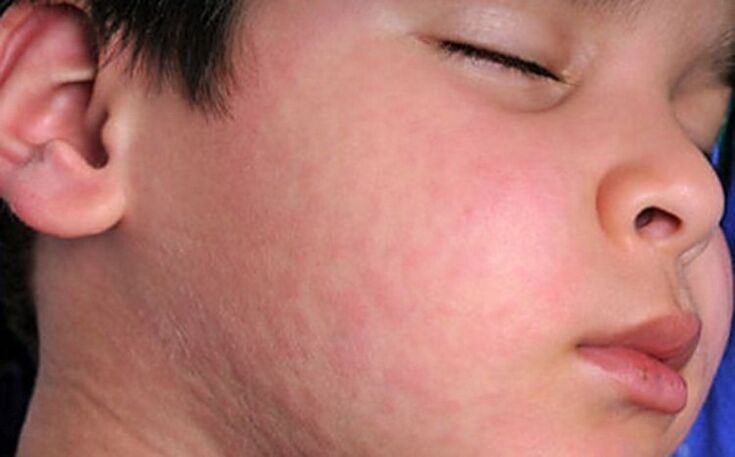
Worm eggs are microscopic in size. They are invisible to the naked eye, they can be everywhere - in the ground, on the handrails of transport vehicles, on handles, in the sandbox of children, on the fur of our favorite.
How can worms be prevented, or if they have already occurred, how can we avoid dangerous complications?
Symptoms of helminths in humans
No one can consider themselves immune to infections caused by worms. Even with the strictest adherence to hygiene rules. To minimize the risk of infection, you should be as well informed as possible about the symptoms of human intestinal worms and the prevention and treatment of helminthic infections.
The most common helminth patterns:
Wormwood.Parasites belong to the class of nematodes and are round worms in cross section. The length of the female reaches 350 mm, the males are much smaller. Cylindrical worms are dangerous in both the intestinal and migratory stages.
Intestinal localization of parasites in complex forms can lead to intestinal obstruction, the release of adult tapeworms into the airways, and the risk of suffocation, biliary obstruction, and other complications. The migratory phase threatens to penetrate the lungs and other organs with the occurrence of severe pathologies.
Ascariasis infection is caused by parasitic eggs that leave the patient’s intestines in the feces and reach the invasive stage in the soil.
- Diphyllobotrium latum.This is a class of cestodes, one of which is represented by a broad tapeworm. Their characteristic is that they have 3 owners. The main organism in which worms develop into mature individuals is a person and some animals (cats, dogs, pigs, etc. ). Intermediate hosts for diphyllobotrium latum are freshwater crustaceans. Medium supplement - fish (perch, pike, beef). The broad tapeworm is infected by consuming poorly cooked fish infected with parasitic larvae - plerocercoids.
Pinworms.These are nematodes like roundworms, but much smaller in size. The length of the female is not more than 10 mm and that of the male is not more than 5 mm. Enterobiasis is one of the most common helminthiasis. Children are particularly sensitive to them.
The most common manifestation of enterobiasis is anal itching. This can be explained by the fact that females enter the perianal zone to lay eggs. In the skin folds, the embryos reach an invasive state in 5-6 hours. If it gets on your hands when scratched and then swallowed, it will lead to re-infection.

Ways of infection
The ways in which worms infect are determined by the invasive form of the parasite and the way they enter the host.
Most parasitic worms have two infectious forms - eggs (called oncospheres in some cestodes) and larvae. The latter are sometimes called Finns or Cysticerci. Eggs are microscopic in size, usually several tens of micrometers. The size of the larvae can reach tens of millimeters.
Most commonly, worms are transmitted orally through the mouth.But certain types of parasites can penetrate the skin or with insect bites. When eggs are swallowed, the embryos in them fall off their shells, penetrate the bloodstream through the intestinal wall, and the blood carries them throughout the body. Depending on the type of parasite, they can settle in the liver, lungs, heart, pancreas, kidneys, brain, eyes.
In the case of larval infection, the intestinal localization of the parasite is most common. Due to their significant size, the larvae cannot penetrate the blood vessels and migrate with the blood. They remain in the gut, cling to the wall and become sexually mature and then begin to multiply.
Wormsticks usually leave the gastrointestinal tract with feces. In some cases, such as cestodosis, the evacuation of eggs from the intestinal tract may be carried out by fragments of worms - proglottids. They come out of the intestines on their own through the anus.

The main types of helminthic lesions
The effectiveness of the treatment of helminths in humans depends on the precise determination of the clinical picture and the nature of the lesion caused by the parasite in the body. And these, in turn, depend on the stage of invasion - intestinal or migratory.
The intestinal stage of the invasion.In the intestinal tract, the main damage occurs in the patient's digestive system, especially the gastrointestinal tract. The worms damage the intestinal mucosa with their suckers. This leads to inflammatory processes and disruption of the gastrointestinal tract.
In addition to some of the nutrients being absorbed by the worms, the absorption function of the intestines is also impaired.Anti-enzymes released by parasites reduce gastrointestinal digestibility. All this leads to a lack of nutrients, vitamins and trace elements in the patient's body.
In addition to antienzymes, worms secrete other metabolites that act as toxins to the host. Added to this is the decay of the bodies of dead worms. As a result, the patient's body is exposed to severe poisoning.
Some types of parasitic worms are able to invade adjacent organs and tissues from the gastrointestinal tract — the bile ducts, gallbladder, liver parenchyma, and other systems. For example, adult tapeworms can penetrate the host's respiratory system in the event of a high-intensity infection. In the case of a large number of parasites, mechanical obstruction of the intestine is possible. This can be observed in both tapeworms and tapeworms.
When parasitic worms enter the liver parenchyma, abscesses can form that require surgery.Intestinal perforation with the penetration of the contents of the gastrointestinal tract into the abdominal cavity and the development of peritonitis is not ruled out. The harmful effects of adult worms can lead to inflammation of the pancreas, gallbladder and gallbladder.

migration phase.Due to the possibility of larval embryos entering almost any organ, the migratory phase of the invasion may exceed the intestinal phase in terms of the severity of the consequences.
Larvae that develop from eggs form inflammations and infiltrates in the organs and tissues. When this occurs in the lungs, the invasion manifests itself in the form of bronchitis, pneumonia, asthma syndrome.
When parasite eggs penetrate the brain (such as the oncospheres of cestodes), single or multiple vesicular fins form in their tissues. Their size can reach the size of a tennis ball. Due to the proximity of cysts to brain tissue, their surgical removal carries a high risk of purulent bladder rupture and the development of secondary infection.
Poisoning the patient's body with metabolites of living worms and toxins from the decay of dead bodies leads to allergic reactions. They result in fever, skin manifestations, headache and dizziness.

Symptoms
The symptoms of helminth infection depend on many factors. There are certain types of invasion, but few of them.Most parasitic worms present with symptoms similar to other diseases.This makes it difficult to make a diagnosis. These common symptoms include:
- Complete deterioration, physical and mental weakness.
- Nausea, vomiting.
- Stool disorders, constipation and diarrhea.
- Discomfort, difficulty, abdominal pain with different localizations.
- Appetite change up or down.
- Weight loss without explanation. Including an increase in the amount of food consumed.
- Itching in the perianal region, feeling like something is moving there.
- Allergic manifestations in the form of skin rashes.
- Cough.
- Difficulty breathing, asthma syndrome.
- Bruxism. Gnashing of teeth during sleep is common in children with itching in the anus.
- Increased irritability, irritability, insomnia, chronic fatigue, depression.
- Headache.
- Elevated temperature, most often subfebrile. But sometimes it rises to high values.
- Dizziness.
In the initial stages of invasion, the symptoms may be completely absent or so insignificant that they are not given much significance. In the future, as the intensity of the disease increases, the symptoms will become more pronounced.
Symptoms of helminths in human blood can vary depending on the organ in which the migrating embryos are located.If their location is found to be in the lungs, the patient may have a fever and breathing problems.Usually, in these cases, the infection is accompanied by a cough - infertile or sputum, which may be orange in color. The latter suggests that the larvae damaged small blood vessels in the lungs.
Symptoms of intestinal worm are accompanied by nausea, vomiting, heaviness and abdominal pain, copious salivation, damaged stools and weight loss.
Attention.In case of severe hepatic invasion, abscesses may form by breaking the purulent contents into the abdominal cavity. Such a development of the disease endangers the life of the patient.

Drug treatment
The treatment of an invasion depends on a number of factors. The main ones are the type of parasitic worms, the location of their localization, the stage of the disease (migratory or intestinal), the intensity of the infection, the condition of the patient. But in all cases, treatment must be preceded by a diagnosis of the disease.
The most common diagnostic test for infections caused by parasitic worms is a stool test. If a diagnosis is not sufficient, a general biochemical and / or enzymatic immunoassay is performed.Hardware diagnostics can also be used - ultrasound, radiography, MRI, etc.With a complete picture of the disease, your doctor will prescribe anthelmintic medications.
Important.Treatment with medicines containing a strong active substance can cause side effects. This limits drug use in certain patient groups. Especially for pregnant and lactating women, children under certain ages, patients with certain viral and infectious diseases.
Various drugs are prescribed to control intestinal nematodes and to kill extraintestinal nematodes.
Important.They often take two courses, including a 2-3 week break. This is because most antiviral drugs only kill adults. Their larvae and eggs remain intact. After the incubation period, a new generation of worms may emerge from them, which will require a second course to destroy.

Use of folk remedies
Treatment with folk remedies takes more time than drug therapy. But this relative disadvantage is offset by the softness of the herbs and the lack of side effects.
There are a number of herbs that have anthelmintic effects - nettle, tansy, celandine, wormwood, horseradish and many more.Antiparasitic plants contain ingredients that are toxic to cestodes, nematodes, and trematodes, and generally have a bitter taste.
Many anthelmintic herbs also have antiseptic and antibacterial effects. Their effectiveness depends on the correct preparation and administration of the dosage forms. Here are some of the most popular herbal preparations. But you have to understand that this is just a small part of what actually exists.

Pumpkin seeds
It is no exaggeration to say that pumpkin seeds are the most popular anthelmintic. They contain cucurbitin, which is very effective against nematodes and cestodes. Pumpkin seeds can be used not only for treatment but also for prevention.
Most of the cucurbitin is found in the film, which is located between the core and the shell.Therefore, the seeds should be consumed unpeeled. For treatment, 300 g of seeds should be eaten at a time. 100 g is sufficient for prevention and 70 g for children. Pumpkin seeds can be used to make solutions that are effective against worms localized in the colon.
Garlic
Garlic is a universal drug that is no worse than pumpkin seeds. It contains phytoncides and essential oils that have a depressing effect on all kinds of parasitic creatures. Garlic is very active against nematodes, especially ascaris.
Soda
Parasitic worms do not tolerate alkaline conditions well, so baking soda is an effective drug against them. It can also be taken orally, but the greatest effect of sodium bicarbonate is achieved by making an infusion solution. It should be used when localizing nematodes or cestodes in the colon.
Honey
Honey does not have to be advertised as a medicine, but not everyone knows that it is also effective as an anthelmintic. To take it for this purpose, you need half a teaspoon 9 times a day.You should refuse food during treatment during the day.
Only fresh vegetables are allowed the next day. Because honey has no contraindications and side effects, it can be used to treat young children. We recommend that you give them a glass of water sweetened with a teaspoon of honey.

carrot juice
Even official medicine, which is sometimes very strict with folk remedies, recognizes that carrot juice has an anthelmintic effect. The amount of juice consumed at one time is not limited by any requirements, everything must be within reasonable limits.
Castor oil
Several species of nematodes and cestodes are localized in the gut. Some laxatives work well against them, especially the familiar castor oil. This recipe is suitable for adults. Mix 80 ml of cognac with castor oil and drink it in a sip before going to bed.
The procedure is performed for 3 days. Children will receive a sweet drink (compote, juice, tea) at 1-2 in the morning, followed by 15-30 g of castor oil in half an hour.
Conclusion
If the parasitic worms do not appear unambiguously (e. g. , in the form of whole individuals or fragments thereof in the feces), it is almost impossible to determine the presence of the invasion on its own. Therefore, do not hesitate to contact an infectious disease specialist at the first appearance of symptoms suggestive of infection.
There are tools in your arsenal that allow you to create an invasion with a one hundred percent probability. Delay in the clinic or self-diagnosis based on self-diagnosis can end sadly, even with death.






































